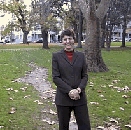My term on the Board of IAHPC is drawing to a close, so this is an opportunity to thank the Organisation for allowing
me to participate in their work and to be associated with so many dedicated and inspiring leaders in palliative care - people who are able to recognise a deep bond with colleagues in resource poor
areas and are stirred to work with them to mutual benefit. It has been a privilege.
My work at present is in a comprehensive cancer centre, the Peter MacCallum Cancer Centre in Melbourne, Australia. The
particular challenge I face in my day to day work is to work at the interface of palliative care and cure-directed / life-prolonging care. Too often this results in conflict. In a sense, this is
to be expected for it creates a healthy tension to "keep us all honest." It certainly can be uncomfortable and at times painful. How often have we vented our frustrations in the privacy
of our team at what appears to be futile and burdensome treatments, a lack of clarity in the goals of care, and the failure to effectively recognise the inevitability of dying and imminent death.
I wonder how often our oncology colleagues have similarly wrung their hands at our perceived nihilism, our readiness to diagnose dying, our push for the 'transfer to hospice' rather than that one
more attempt to stem the tides of death.
Iatrogenic death appears to be a particular blind spot for all of us. I reflect on a recent case of a patient with irreversible
and fatal neutropenic sepsis. While feelings of guilt and distress in the treating teams are understandable, they ought not to result in inadvertent additional burden to the patient. Failure to
provide optimum comfort care and symptomatic management of terminal delirium and other symptoms in such patients is a failure in our basic duty of care. Reluctance to manage end of life symptoms
seems to point to an underlying and deep seated confusion that such management will hasten death. As Ellershaw teaches in his end-of-life integrated care pathways, and as many others have beautifully
articulated, symptomatic measures to relieve suffering do not preclude other carefully considered efforts to reverse life-threatening complications. Rather these measures are part of a comprehensive
coordinated management. In my place of work, it seems that the balance between palliation and life-prolonging efforts is frequently tilted to the detriment of optimum end of life care. Many opportunities
for clarifying patient and family priorities are lost in the medical maze of well-intentioned but excessively burdensome therapies. How much this stems from a death-denying culture which underlies
modern cancer therapy is a point for philosophical debate.
My final comments rise out of my own recent personal experience. I have been on part-time maternity leave for the past
3 years, following the birth of 2 beautiful sons. During this time, our department struggled without locum cover because of the lack of trained and available palliative care consultants in this
country. This situation is not unique in Australia. While we are fortunate to have established training in palliative medicine that is recognised by the Royal Australasian College of Physicians
and a recognised Chapter of Palliative Med (established in 2000) which oversees training of future consultants, we struggle to attract trainees to this field. This contrasts markedly with the UK
where palliative medicine is a popular medical specialty for trainees. An explanation for the lack of trainees in Australia is the paucity of consultant physician positions in the workforce - surely
a chicken and egg problem. It seems to me that we must lobby more aggressively for government and hospitals to establish such consultant positions while we are training doctors to fill them.
For this, we need the courage of our convictions that the work we do will stand the test of time and we must have faith that palliative care will be increasingly appreciated as an essential component
of excellence in modern healthcare.





